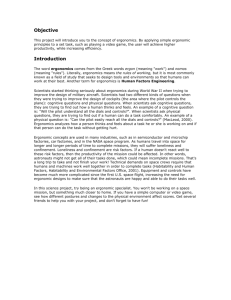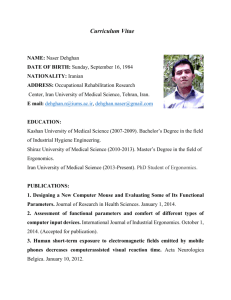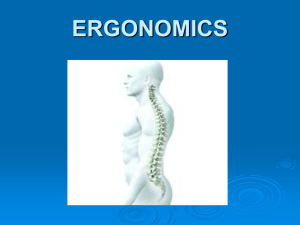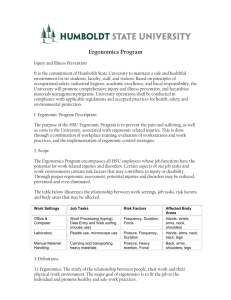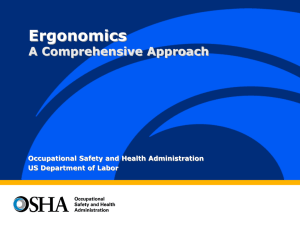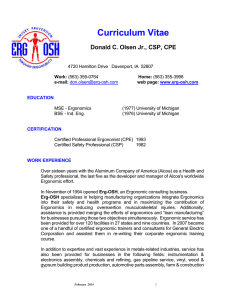Ergonomics Program Department of Environmental Health & Safety Procedures
advertisement
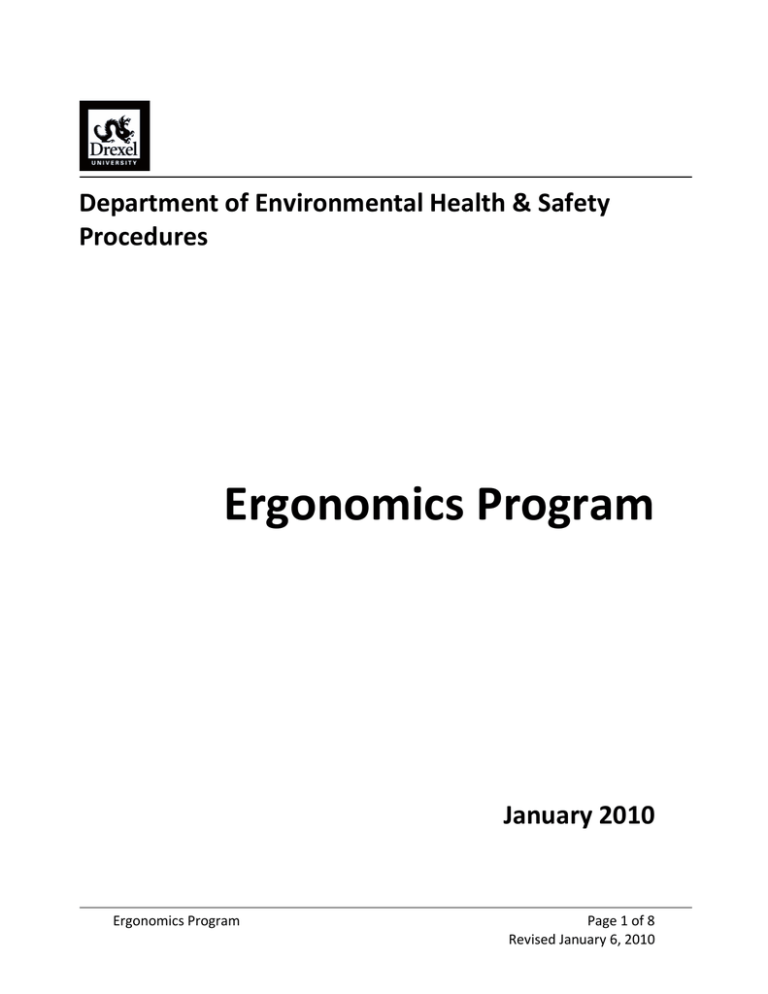
Department of Environmental Health & Safety Procedures Ergonomics Program January 2010 Ergonomics Program Page 1 of 8 Revised January 6, 2010 Table of Contents I. Introduction II. Policy III. Scope IV. Responsibilities V. Definitions VI. Methods of Compliance A. Accident and Related Data Analysis B. Workplace Analysis C. Hazard Prevention and Control D. Medical Management E. Training VII. Procedure Review and Continuous Improvement VIII. Appendices Ergonomics Program Page 2 of 8 Revised January 6, 2010 I. INTRODUCTION On January 16, 2001, the Occupational Health and Safety Administration (OSHA) published the 29 CFR 1910.900: Ergonomics Program Standard, in the United States Federal Register. That standard was subsequently revoked in late 2001. Meanwhile, work‐related musculoskeletal disorders (WMSD) still account for at least one third of all workers compensation costs (AIHA, 2004). Despite the fact that the OSHA Ergonomics Program Standard has been rescinded, there are numerous consensus documents available providing valuable tools regarding ergonomic workplace injuries, control, and design. The primary goal of this program is to identify the excessive physical demands on the workforce at workstations and during job tasks; along with corresponding control methods. II. POLICY This procedure provides the minimum requirements to ensure that the Ergonomics Program is successfully implemented and it is the policy of Drexel University to utilize sound ergonomic principles to provide a process for preventing the occurrence of WMSD and their precursors. The purpose of this program is to establish responsibilities and procedures in order to promote continuous improvement in workplace ergonomic protection and to reduce the number and severity of WMSD caused by exposure to ergonomic risk factors. III. SCOPE This procedure is designed to protect all Drexel University and Drexel University College of Medicine (DUCOM) personnel from WMSD including cumulative trauma disorders and overexertion injuries. Ergonomics Program Page 3 of 8 Revised January 6, 2010 IV. RESPONSIBILITIES A. Department of Environmental Health and Safety Develop and coordinate the implementation of the overall Ergonomic Program; Serve as the primary resource for ergonomic principles, practices and the control the risk factors. Assess the need for ergonomic assessments and evaluations to be conducted through identifications of workstations, job tasks, and surveys; Perform ergonomic Job Safety Analysis (JSA) for jobs that place employees at high risk of developing WMSD, based on the screening tools used; Provide information to employees through training and education methods about the types of injuries, symptoms and how to reduce the risk of WMSD. B. Department Management Implement and enforce this procedure; Consider the potential for WMSD occurrence when purchasing equipment or making process changes; Encourage employee reporting of ergonomic hazards and suggestions for methods to eliminate or reduce the hazard; Coordinate employee training schedules with the Department of Environmental Health and Safety. C. Employees Comply with the information outlined within the University’s Ergonomic Program; Perform assigned duties in a safe manner, utilizing sound principles of body mechanics, as they relate to the tasks, along with the designated equipment and work practices. Report any discomfort and/or concerns regarding ergonomic hazards or stressors to their immediate supervisors and follow the guidance provided by medical providers and/or ergonomics training. V. DEFINITIONS Cumulative trauma disorders (CTD): refers to a category of physical signs and symptoms due to chronic musculoskeletal injuries where the antecedents appear to be related to some aspect of repetitive work. Ergonomics Program Page 4 of 8 Revised January 6, 2010 Discomfort Survey: a survey that records the level of comfort or discomfort felt by individuals in the performance of work tasks. These surveys typically record the level of discomfort by body part affected. Ergonomics: the field of study and practice relating to the matching of the physical and psychological demands of tasks or activities with the physical and psychological capabilities of people. From the Greek, the word "Ergon" means "work" and "nomus" means "natural law". Ergonomics literally means the laws of the science of work. Overexertion Injuries: injuries arising from a specific event where the physical demands of a task exceeded the physical capabilities of a person attempting to perform that task. Work‐related musculoskeletal disorder (WMSD): An injury or an illness of the muscles, tendons, ligaments, peripheral nerves, joints, cartilage (including intervertebral discs), bones and/or supporting blood vessels in either the upper or lower extremities, or back, which is associated with musculoskeletal disorder workplace risk factors and which is not the result of acute or instantaneous events. VI. METHODS OF COMPLIANCE This section describes the five (5) key elements of the Ergonomic Program. All of the steps shall be taken to complete the process; however, the sequence of steps may vary dependant upon the circumstances. All assessments (whether office workstation, laboratory, or other) will be scheduled and performed by the Department of Environmental Health and Safety. A. Accident and Related Data Analysis Whenever a WMSD occurs, a process must be initiated to identify workplace ergonomic risk factors that may be present. Once identified as a potential risk factor either hazard abatement shall occur or a JSA performed. Apparent trends will be analyzed and corrective action initiated where warranted. Where precursors of WMSD exist, discomfort surveys may be considered for use. These surveys can help to prevent the progression of conditions from discomfort to pain and injury/illness. Ergonomics Program Page 5 of 8 Revised January 6, 2010 B. Workplace Analysis A program for the conducting of baseline screening surveys will be implemented upon activation of this policy, and whenever the physical requirements of surveyed jobs change. These surveys will be performed for those jobs where there are suspected ergonomic risk factors likely to lead to WMSD or the presence of confirmed presence of WMSD. A JSA will be performed for jobs that are identified to place employees at high risk of developing WMSD. The JSA will be performed by trained and qualified individuals with the appropriate tools to evaluate WMSD. The reporting of ergonomic hazards is encouraged by management. It is recognized that in many cases the most practical solutions to ergonomic problems related to a job are offered by those most familiar with that job. C. Hazard Prevention and Control Each WMSD will be tracked through to hazard abatement. Where permanent controls are not readily identifiable, initial controls may be applied. The Department of Environmental Health and Safety shall consider the findings of all ergonomic assessments and recommend control measures. Measures will be applied to control or prevent the ergonomic hazards identified, selected in the following order of preference: Engineering controls, i.e., physical changes to the job or equipment that reduce WMSD hazards. Engineering controls are commonly recommended to improve the workstation design and provide the user with the tools necessary to perform the job safely. They may include substituting better designed keyboards, chairs, ergonomically designed mice, adjustable height tables, etc. Administrative controls, such as alternation of tasks or job rotation; Education of the user in the proper use of equipment available or self‐care measures such as stretching exercises, breaks, etc.; Careful selection of personal protective equipment (PPE) to avoid adding ergonomic stress to performance of specific tasks that require PPE. Ergonomics Program Page 6 of 8 Revised January 6, 2010 Equipment purchases shall be made with due consideration given to the potential for the ergonomic hazards. Department Supervisors shall be responsible for purchasing ergonomically sound equipment and promoting safe use of the equipment by employees. D. Medical Management Employees experiencing signs or symptoms of a WMSD must report them immediately to their supervisor or other responsible person. If medical treatment is required, the employee or supervisor should contact public safety or the Department of Environmental Health and Safety. Medical evaluations are available and shall be provided when there are employee complaints of symptoms or disorders. Procedures for reporting occupational injuries and illnesses are detailed elsewhere. History and physical evaluation of the problem will be performed and appropriate medical treatment provided, including but not limited to, rest (removal from work), modified or restricted work, splinting, physical or occupational therapy, work hardening, medications and adaptations of the work environment/work stations. WMSD are covered through the provisions of Workers' Compensation as required by the Pennsylvania Workers' Compensation Act. The use of back, wrist, and other supports is only advised when recommended by physicians treating individuals for a medical condition. These devices are not currently recognized as effective for the prevention of WMSD except for use with individuals who are already suffering some physical impairment. E. Training Employees with the presence of ergonomic risk factors in their jobs will be provided ergonomic awareness training including safe back lifting. The training will address identification, assessment, risk factors associated with the development of WMSD, signs and symptoms of WMSD, methods of prevention and control, and reporting procedures. Ergonomics Program Page 7 of 8 Revised January 6, 2010 VII. PROGRAM REVIEW AND CONTIUOUS IMPROVEMENT The Department of Environmental Health and Safety shall review the Ergonomic Program annually at a minimum to ensure that the procedure is current, practical, and compliant with all applicable regulatory requirements. VIII. APPENDICIES Appendix A – Office Workstation Ergonomics Checklist Appendix B – Discomfort Survey Ergonomics Program Page 8 of 8 Revised January 6, 2010


